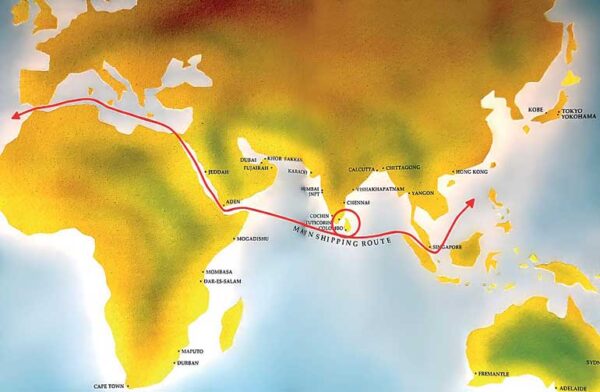
Source:FT
- A proposed global initiative to obtain a waiver on debt repayments for Sri Lanka, to redress the damage caused to its economic resources by carriers using our exclusive economic zone
The island at the centre of an expressway
For centuries, the world’s maritime traffic on the Great East-West Shipping Lane, (transporting cargo both to and from the Atlantic ocean, starting from east-coast of the USA, via UK, Europe, the Mediterranean Sea, through the Suez Canal, passing Sri Lanka, Singapore, Hong Kong, China, South Korea, Japan, and to the Pacific Ocean) has been moving very close to Sri Lanka, strategically located at the centre of the Indian Ocean, taking the shortest and the fastest possible route from Aden to Singapore, and also on the return voyage.
A sea lane that saves billions for global trade
This ‘Ocean Expressway’ enables vessels to sail, just outside the Sri Lanka’s territorial waters – about 10 miles off the Port of Hambantota, and Dondra Point, the southernmost location of Sri Lanka.
This course allows for cargo ships to sail in a straight line rather than sailing in a circular route outside of the 200 nautical mile Exclusive Economic Zone (EEZ) of Sri Lanka. This path enables a vessel to reduce its distance travelled by 400 miles, thereby saving one day of sailing time (aircraft also fly across this zone which saves about one hour of flying time).
Every year, 35,000 ultra-large container vessels (ULCV) and bulk carriers, and another 5,000 ultra-large Crude Oil Carriers (ULCC) journey through Sri Lanka’s Ocean Expressway which realises importers, exporters, freight companies and consumers, savings to the tune of $ 8 billion per year – without a cent of revenue being given to Sri Lanka.
To provide some perspective on the volume of traffic and the cost of passage, the 20,000 vessels that passed through the Suez Canal in 2020 paid $ 6 billion to Egypt. In comparison, Sri Lanka’s ‘Ocean Expressway’ not only enabled vessel and aircraft owners/operators to reduce their cost and enhance profits by about $ 8 billion per annum, but also allows them to offload Carbon Dioxide (CO2) emitted to the tune of 20 million tons annually on Sri Lanka without any levy.
Sri Lanka currently only earns revenue from the 5,000 ships that make direct calls annually to its ports. The 45,000 aircrafts fly over Sri Lanka annually more or less in a similar manner.
Assuming additional risk with no reward
Over a long period of time Sri Lanka’s economy has been bombarded by the above mentioned CO2 and pollution causing crop failure, droughts, floods, landslides, famine, human-elephant conflicts, and threatening our food security, supply of clean water and our biodiversity.
This ocean pollution and the noise is also driving away the endangered blue whales off the island’s coast, also the other sea creatures and diminishing our fish supply. The incremental yet compounding effects have begun to threaten the very livelihood of the peasant farmers, fisherman, and self-employed daily wage earners who comprise of more than half of Sri Lanka’s population – leading to increase in poverty ratios, and threatening sustainable development. Beach pollution, smuggling and gunrunning are other threats.
Sri Lanka’s ‘Ocean Expressway’ carries about 30% of the world trade, transported by the world’s largest TEU 20,000 capacity container ships, 350,000 MT capacity bulk carriers, 300,000 MT crude-oil tankers and aircrafts with 500 seating capacity.
The annual world trade carried by these 35,000 vessels, 5,000 tankers and 45,000 aircrafts crisscross Sri Lanka’s EEZ annually, at their pleasure and convenience, without a levy for passage. Big producer and consumer economies, big corporations, big governments and their citizens around the world all benefit from the resulting reduced transportation costs, and faster delivery, whilst the fragile economy of Sri Lanka and its citizens have been burdened by the pollution being offloaded 24 hours per day, and 365 days of the year for decades.
Sri Lanka as a country had emitted 21 million tons of CO2 as documented in the 2018 World Bank study, and has taken on an additional of 20 million tons of CO2 disbursed by passing ocean carriers. This situation leaves the small island of Sri Lanka having to absorb and neutralise a pollution problem double in size without any assistance.
This burden does not allow for a level playing field, and is not tenable. These difficult conditions have continually eroded the Sri Lankan GDP by about 8% each year, for decades.
In addition to the economic impact of these environmental factors affecting Sri Lanka, due to COVID-19, the nation has also lost $ 4 billion per year in tourism income, and the nation’s external reserves fell to its lowest level of $ 3 billion in July 2021 from a pre-COVID-19 high of $ 8 billion in December 2019. This has caused the parity to the US Dollar to rise from LKR 190 per dollar to LKR 225 per dollar.
Further, Sri Lanka’s debt service requirement of $ 6 billion per year, the recent 60% rise in crude oil import prices, and the pressure to ease temporary import restrictions that were imposed to arrest the foreign exchange shortage is now crippling the economy.
This situation now requires thinking that is “out of the box” as well as the implementation of immediate measures to mitigate this foreign exchange crisis.
An opportunity to mitigate an immediate problem
The immediate economic crisis facing Sri Lanka comprises an external debt which stands at $ 60 billion (about 80% of Sri Lanka’s GDP), a debt service requirement of $ 6 billion per year and dwindling foreign exchange reserves of $ 3 billion as of July 2021 from a pre-COVID-19 high of $ 8 billion in December 2019.
Current land based development programs being implemented to rebuild foreign exchange levels are either facing opposition from the people, owed to enforced acquisition of scarce land, or are not progressing at the required pace needed to overcome the burden of this economic problem.
By looking to Sri Lanka’s ‘Ocean Expressway’ and the unused sea within our Exclusive Economic Zone (EEZ), there lies an opportunity to negotiate a waiver of the repayment of external debt from global trade partners.
In this regard, as an independent professional and citizen of Sri Lanka, I have researched and published a concept paper entitled “SEA – Sri Lanka’s Competitive Advantage” (published 2 March 2021 – ISBN 978-624-97686-0-4) proposing that international development partners, who are the ultimate beneficiaries of the economic benefits of cheaper and quicker cargo delivery via Sri Lanka’s ‘Ocean Expressway,’ could waive off our external debt repayment obligations against the damage caused to economic resources of Sri Lanka by ocean passage through our Exclusive Economic Zone (EEZ).
The one sided equation
For the carriers and beneficiaries of cargo:
1. The Sri Lankan Ocean Expressway saves one day of sailing per voyage.
2. Crossing Sri Lanka’s EEZ saves commercial airlines one hour of flying time.
3. 30% of world trade moves through the EEZ, comprising 35,000 ultra-large container vessels (ULCV) and bulk carriers, another 5,000 ultra-large crude oil carriers (ULCC), and 45,000 aircraft per year.
4. Carrier’s and beneficiaries of cargo save $ 8 billion per annum by crossing Sri Lanka’s EEZ.
5. Quicker delivery of cargo reduces the global stock holding inventory cost by about $ 2 billion per year.
6. The ships have absolute freedom of navigation and unimpeded access through Sri Lanka’s EEZ, and they accrue operating cost and bunker savings without contributing any revenue to Sri Lanka.
The impact on Sri Lanka’s economic resources
1. Whilst in passage through or passing over our EEZ, ships and aircrafts offload 20 million tons of CO2 on Sri Lanka each year, and have been doing so for the past decades.
2. The resulting damage to Sri Lanka’s economic resources over this time is assessed at about 8% of GDP per annum (approximately $ 8 billion in 2020).
3. To compound matters, the COVID-19 impacted Sri Lankan economy has lost $ 4 billion in tourism income and $ 2 billion in worker remittances.
4. Sri Lanka’s debt servicing requires $ 6 billion per annum.
5. Sri Lanka’s foreign exchange reserves fell to $ 3 billion in July 2021 from $ 8 billion pre-COVID-19, forcing the parity to the US Dollar to rise to Rs. 230 from Rs. 190, and enforce import restrictions further impacting economic activity of the nation.
For decades, Sri Lanka has been silently suffering, taking an environmental and economic beating, whilst helping the world trade, and now its fragile economy is now in peril.
Sri Lanka needs help from the global powers to redress this one sided equation which negates the principle of reciprocity and works against sustainable development.
To provide some perspective, the major beneficiaries of cargo carried are the G7 Countries, People’s Republic of China, and the Fortune Global 500 Companies. As per the World Bank and Wikipedia the 2020 GDP of USA was $ 21 trillion, China was $ 15 trillion, and the revenues of the Fortune Global 500 Companies amounted to $ 33 trillion. In comparison, Sri Lanka has a GDP of only $ 85 billion and a debt of $ 60 billion, which is just a fraction of the size of the revenues earned by these beneficiaries.
To overcome the imbalance against Sri Lanka, a global initiative is required to be put in place the form of a “waiver” on debt repayments set-off against the damage caused to the economic resources of Sri Lanka.
A global initiative for consideration
The debt repayment “waiver” being asked for from the beneficiaries of passage and use of Sri Lanka’s ‘Ocean Expressway’ is to provide Sri Lanka with a quick supply of life-giving economic oxygen. Providing time and opportunity for the nation’s economy to regain its strength and continue its development going forward.
The big governments and big economies of the G7 Countries, People’s Republic of China, and multilateral agencies such as the World Bank, ADB, IBRD, IDA, IMO, WTO and UNDP are requested to work out a road map for a waiver of debt repayment for Sri Lanka, under the World Bank umbrella.
Considering the gains made by the Fortune Global 500 Companies who are also beneficiaries of cost savings of passage through Sri Lanka’s EEZ, are respectfully requested to redress Sri Lanka’s predicament, by the provision of CSR grants/donations to this initiative, under the purview of the World Bank.
Well-wishers of Sri Lanka, please support this urgent humanistic gesture for Sri Lanka, review and share with others to create awareness and exert continuous pressure on the “powers that be” as a global initiative.
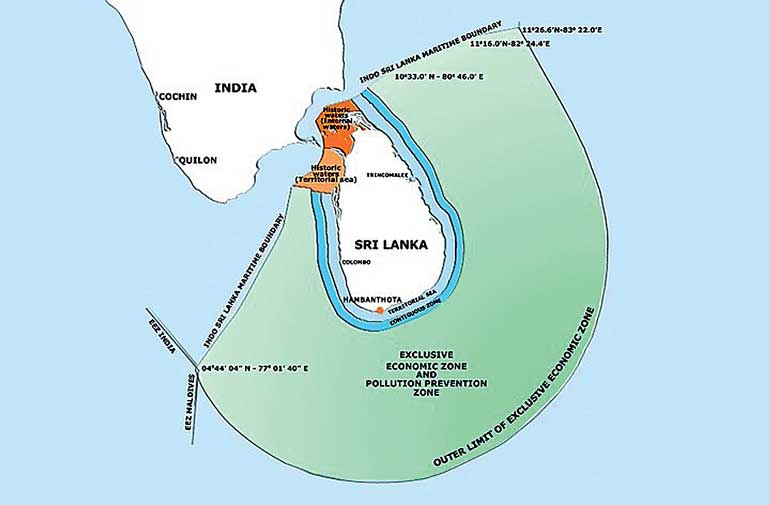
[The writer is an independent Financial Advisor and a Consultant, and an Accredited Director of Sri Lanka, former Chairman – Sri Lanka Ports Authority and Ceylon Shipping Corporation; former Head of Finance/ Planning Zambia Consolidated Copper Mines (Billion Dollar NYSE Listed Company), former Finance Director George Steuarts, a former Independent, Non-Executive PLC Director, and a former Chairman of an Information Tech start-up company. He is a FCMA (UK), FCCA, ACC.Dir.SL, CGMA. He can be reached via email at ranjith_wickramasinghe@ymail.com]

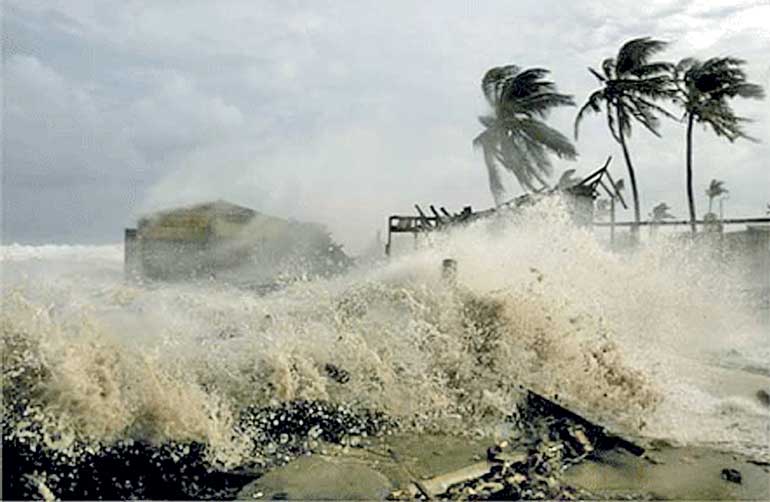
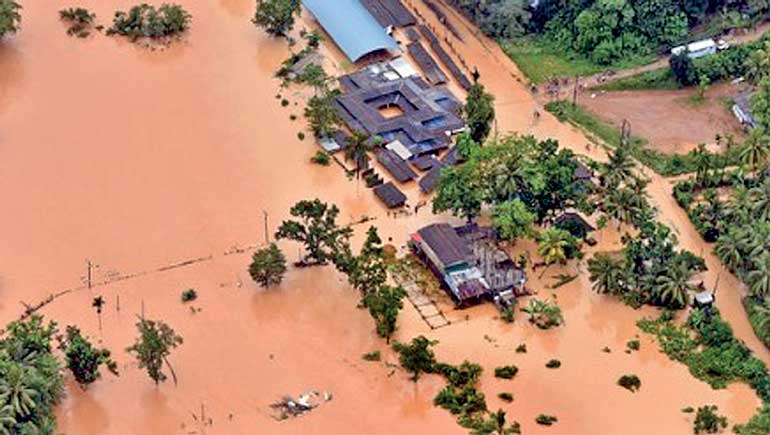
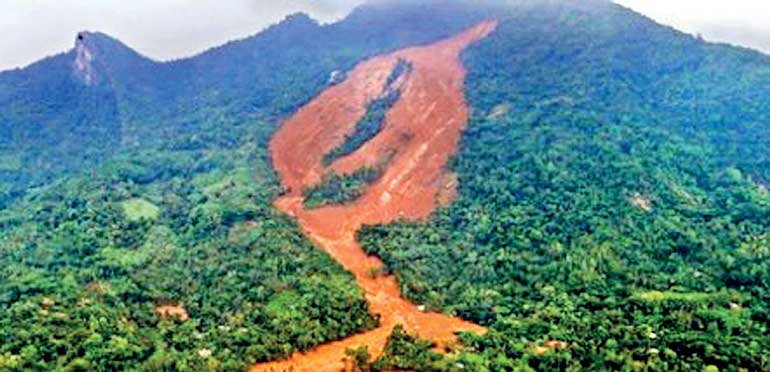

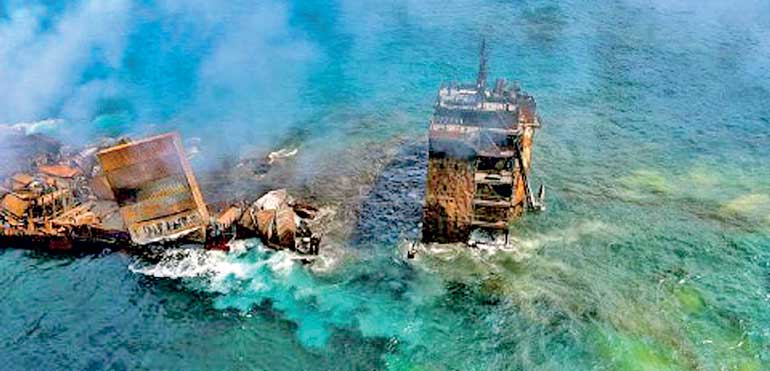

Over a long period of time Sri Lanka’s economy has been bombarded by CO2 and pollution causing crop failure, droughts, floods, landslides, famine, human-elephant conflicts, and threatening our food security, supply of clean water and our biodiversity. This ocean pollution is worsening the situation and the incremental yet compounding effects have begun to threaten livelihoods






